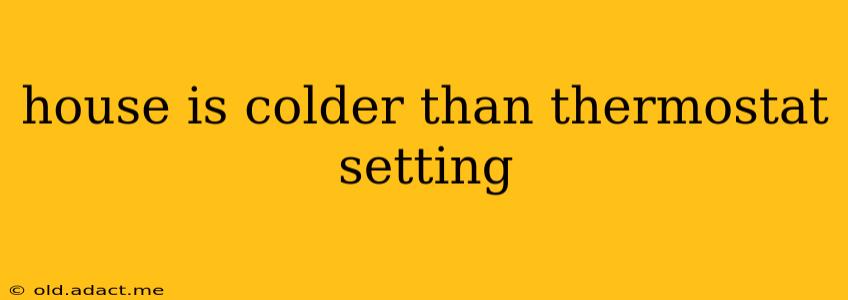Many homeowners experience the frustrating situation where their house feels significantly colder than the temperature displayed on their thermostat. This isn't just a matter of personal preference; it points to underlying issues that need addressing. This comprehensive guide will help you diagnose and fix the problem, ensuring your home is warm and comfortable.
Why is My House Colder Than the Thermostat Setting?
This common problem stems from a variety of factors, often intertwining to create a chilly environment. Let's explore the most frequent culprits:
1. Incorrect Thermostat Calibration or Placement:
-
Calibration Issues: Over time, your thermostat might drift from its accurate setting. A simple recalibration could be all it takes. Many thermostats have a calibration feature in their settings menu; consult your manual for specifics.
-
Poor Placement: Thermostats need to be placed in a location that accurately reflects the average temperature of your home. Avoid placing them near doors, windows, direct sunlight, or heat sources (like fireplaces or appliances). These locations can lead to inaccurate readings and inconsistent heating.
2. Insufficient Heating System Capacity:
-
System Size: Your heating system might simply be too small for your home's square footage. If your home is poorly insulated or has experienced recent additions, the existing system may struggle to keep up with the demand. Consider upgrading to a larger system or exploring energy-efficient alternatives.
-
System Age and Maintenance: Older systems lose efficiency over time. Regular maintenance, including filter changes and annual inspections, is crucial for optimal performance. A poorly maintained system will struggle to deliver sufficient heat, resulting in a colder-than-expected house.
3. Air Leaks and Poor Insulation:
-
Drafty Windows and Doors: Air leaks around windows and doors are significant contributors to heat loss. Caulk, weatherstripping, and window inserts can significantly improve insulation.
-
Insufficient Attic and Wall Insulation: Proper insulation is critical. If your home lacks sufficient insulation in the attic, walls, and floors, heat will escape, leaving you feeling cold despite the thermostat setting.
-
Air Duct Leaks: Leaking air ducts can drastically reduce heating efficiency. Ensure your ducts are properly sealed to prevent heat loss before it even reaches your living spaces.
4. Problems with the Heating System Itself:
-
Faulty Thermostat: While calibration is a simple fix, a malfunctioning thermostat can also cause inaccurate temperature readings or prevent the heating system from functioning correctly. Consider replacing it if recalibration doesn't resolve the issue.
-
Malfunctioning Furnace or Heat Pump: A variety of issues within your heating system can reduce its efficiency. These include problems with the blower motor, heat exchanger, or other components. Professional inspection and repair are necessary to address these issues.
-
Low Fuel Supply: Ensure you have an adequate supply of fuel (gas, oil, or electricity) for your heating system. Low fuel levels will significantly impact heating performance.
5. Other Contributing Factors:
-
High Ceilings: Homes with high ceilings can require more heating capacity to maintain a comfortable temperature.
-
Large Window Areas: Extensive windows, while aesthetically pleasing, contribute significantly to heat loss.
-
Open Floor Plans: While open floor plans offer a sense of spaciousness, they also make it more challenging to maintain consistent heating throughout the house.
What to Do if Your House is Still Too Cold
If you've checked the above factors and your house remains colder than the thermostat setting, it's time to call a qualified HVAC technician. They can perform a thorough inspection of your heating system, identify any malfunctions, and recommend appropriate repairs or upgrades. Investing in professional help can prevent further complications and ensure your home remains warm and comfortable throughout the colder months.
Remember, addressing these issues proactively not only enhances your comfort but also improves energy efficiency and saves you money on your heating bills in the long run.
